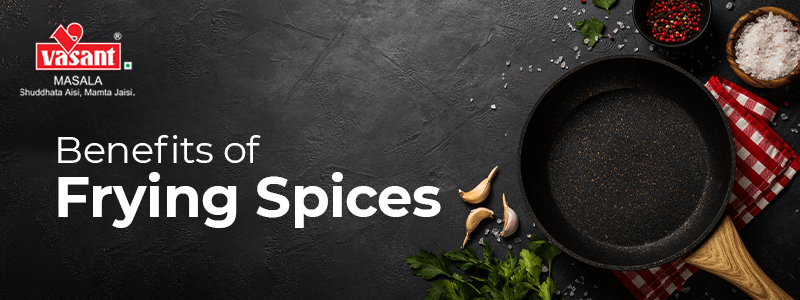
The freshly ground spices are the most intoxicating because they have the best aroma and taste when added to any dish. These spices are heady and complex and their taste evolves during the cooking process. The flavour of these spices depends upon the time and temperature of the oil. We are already aware of the benefits of dry roasting your spices, but today's blog is going to be a little different. In this blog, we are going to discuss the benefits of frying spices in oil or ghee.
Why Should One Fry Spices?
Frying your spices in oil will give it a completely different flavour than dry roasting. When the spices are dry roasted, their flavour of it changes fundamentally, that is, the volatile aromatics start to cook off while the compounds present in the spices recombine to develop new flavours. The newly developed flavours taste earthier and deeper than before. Whereas, the process of frying will only enhance the original flavours, making the spice taste even bolder and more intense. To summon it up, oil fried spices have a brighter and fresher aroma in comparison to dry roasted spices.
A few spices call for frying whole spices and some don't. While powdered spices can be used, fresh whole spices that are fried first and then ground give the dish robustness and an unmistakable silkiness and depth that is often impossible to achieve with ground versions alone. Meanwhile, some recipes call for a combination of whole and ground spices, with the whole ones coming first because they take longer to cook, followed by the other ingredients in quick succession; the ground spices often come last because they are more likely to burn.
Do Fried Spices have a Shelf Life?
As we explained earlier dry spices take away the moisture from the spices which increases their shelf life. Fried spices are just the opposite because of how they are made. Fried masala is often referred to as "wet spices' not only because of the liquid ingredient 'oil' but also often added ingredients like onion and shredded coconut. Therefore, fried spices do not usually last long and should be used immediately for the best tastes.
Also Read : Store the spices right - Do’s and Don’ts
How to Fry Spices?
There are three ways to fry spices. We have mentioned them below.
- They can be fried in a small amount of oil first, then ground.
- Second, they can be slowly fried with onion, a technique is known as 'bhunooing' (slow frying)
- Third, they can be made in a tadka, which is quick and aggressive frying of spices in hot oil, then used as a finishing touch on a dish.
The above mentioned three ways require patience and practice. It is not a difficult task to pull off, but, spices are fragile and they burn quickly if you do not pay attention to their rapid transformation in the oil.
Let's understand these processes in detail.
1) Frying in small quantities of oil:
In this process, oil is heated in a cast iron pan. Once the oil heats up, whole spices and the tougher spices go in it first. Spices like cinnamon, black pepper, and dried chillies. The seeds are in next! At this point, you can add coriander, thinly sliced onions, or even grated coconut. These ingredients will secret some water during the buffering stage, allowing the spices and seeds not to burn. Once everything is well combined, you let the mixture come down to room temperature. Grind the mixture to a fine paste in a spice grinder. This gravy becomes the base of a dish. The one thing you need to take care of is that the spices don't burn because if they do, it will taint the entire batch. The only pro tip here is not to heat the oil to flames and fumes. Keep stirring the spices at regular intervals.
2) Bhooning/ Slow frying:
The purpose of this dish is to develop flavours gradually. It is a slow process wherein the oil is heated and then the heat is turned down just before adding spices like cinnamon, cardamom, anise, and black peppercorns till it starts changing its colour. If you are using onions, they are added right after bhooning the spices and are cooked until they beautifully caramelize. Bhooning makes the gravies tasty, creamy and rich; thanks to the gradual process that leads the spices to release their essential oils with the onion that are melting and sweet. We do not need to grind this mixture. To add to its flavours you could add spices such as chilli powder, turmeric, and coriander, which are usually added during the slow process of cooking. take care of the spices because they shouldn't get scorched.
3) Tadka
Belief or not, the aroma of temperings is irresistible. Tadka is made after the dish has been cooked. It is prepared by heating a tablespoon or two of oil and ghee until it is smoking hot. Small quantities of whole spices like cumin, black pepper, cardamom, and cinnamon are added to it. In contrast to the slow-frying method, the spices are allowed to splatter and sputter, sizzle and pop as they release their aromas into the fat. This piping hot oil is then poured directly onto the waiting dish, setting off a new round of sizzling and crackling. It is usually done to add flavour and aroma to a dish. Tadkas add a subtle spiciness to a dish, providing an understated reminder of the spices that went into it with each spoonful.
Vasant Masala's Online Masala Store ethically produced and genuine spices will not only make the dish taste out of this world but will also add its goodness to your health. Check our page to buy 100% natural spices.

